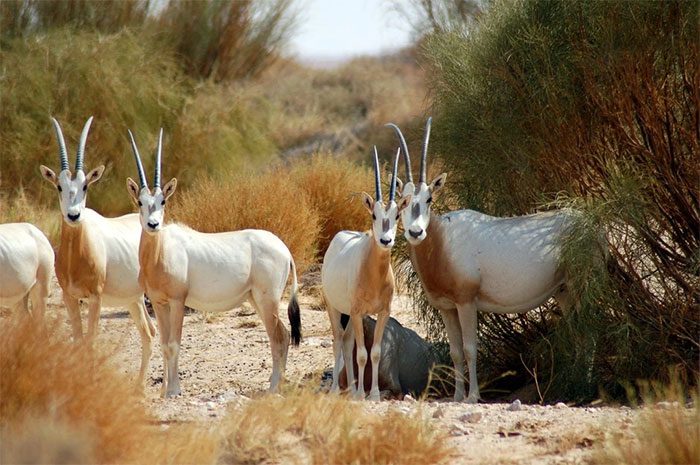510 young Arabian oryx have been born in the wild, marking a new beginning for a species once classified as extinct.
The Arabian oryx (scientific name: Oryx dammah) is a large antelope species adapted to desert, arid environments. This species is distinguished by its long, sword-like curved horns, which is why they are called the Arabian oryx. They were declared extinct in the wild by the International Union for Conservation of Nature (IUCN) prior to the 20th century due to overhunting.

The Arabian oryx population is “reviving” in the wild. (Photo: Marwell Zoo).
However, this species has now made a comeback and is currently classified as “vulnerable”, according to the latest IUCN updates. This is viewed as an encouraging conservation effort stemming from a project initiated by the Sahara Conservation Fund (SCF) since 1985.
The project began with just a few isolated individuals of the Arabian oryx being kept in captivity around the world.
Using a scientific approach, the researchers created a miniature habitat for the last surviving oryx, helping them to recover the species. The chosen location is the Ouadi Rimé-Ouadi Achim Wildlife Reserve in Chad.
In 2016, 21 Arabian oryx were reintroduced into the wild within a protected area. Each individual was fitted with a GPS collar, allowing experts to closely monitor them.
Approximately six months after their release, the first Arabian oryx was born in the wild after more than 30 years.
By 2017, an additional 14 oryx were released into the same area. The project’s goal is to create a healthy herd that can maintain its population independently and avoid natural threats.
As of now, a total of 510 young oryx have been born in the wild. This is an incredible achievement, demonstrating that wildlife reintroduction models can be effective when there is sufficient effort and determination from global organizations.

The Arabian oryx was declared extinct in the wild before the 20th century due to illegal hunting. Their elegant horns are highly sought after by poachers. (Photo: Getty).
“This project is proof that with the right will and resources, we can secure a future for all threatened species worldwide,” said Tim Wacher, a conservation expert at ZSL.
“The change in status of the Arabian oryx from extinct in the wild to vulnerable is a testament to the power of collaborative conservation efforts, and gives us all hope to make a difference in restoring nature,” said Dr. Tania Gilbert, head of the Conservation Science Department at Marwell Wildlife.
Research shows that only 1/4 of species that have gone extinct in the wild are currently part of a restoration program, but the success of this project demonstrates that reintroduction programs can work with international collaborative efforts and conservation initiatives from various organizations.
Professor John Ewen, a researcher at the ZSL Zoological Institute and a lead author of the ZSL study on extinction in the wild, commented: “Projects like the conservation of the Arabian oryx show that it is possible to reverse the fate of these species. With the right will and resources, we can secure a future for all threatened species worldwide.”
The Arabian oryx is a large antelope species adapted to desert, arid environments. This species is known for its long, sword-like curved horns, which is how it got its name. Historically, these oryx were widely distributed across most of North Africa. However, prolonged drought and rampant hunting in the 1980s led to a dramatic decline in their population. Their horns and meat were particularly sought after due to their high economic value. In 2000, the species was declared “extinct in the wild” and only existed in captive collections around the world. |


















































